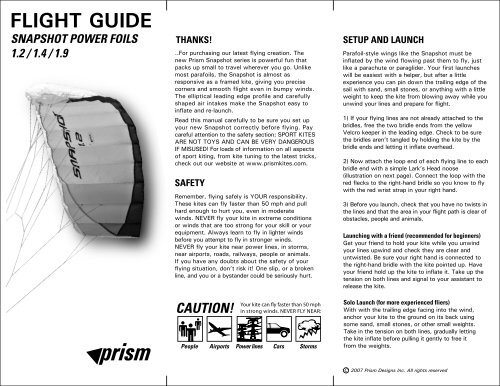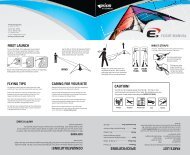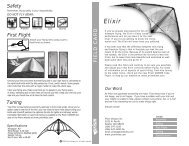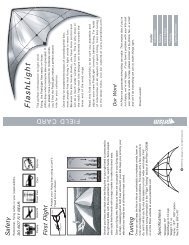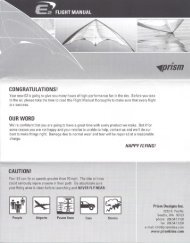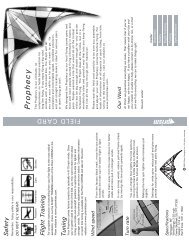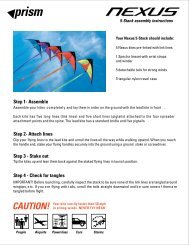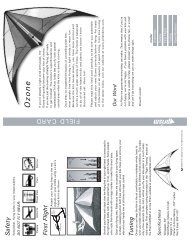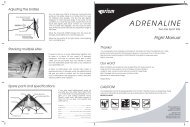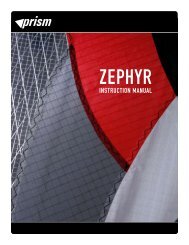Snapshot instructions sketch.ai - Prism Kite Technology
Snapshot instructions sketch.ai - Prism Kite Technology
Snapshot instructions sketch.ai - Prism Kite Technology
Create successful ePaper yourself
Turn your PDF publications into a flip-book with our unique Google optimized e-Paper software.
FLIGHT GUIDESNAPSHOT POWER FOILS1.2 / 1.4 / 1.9THANKS!..For purchasing our latest flying creation. Thenew <strong>Prism</strong> <strong>Snapshot</strong> series is powerful fun thatpacks up small to travel wherever you go. Unlikemost parafoils, the <strong>Snapshot</strong> is almost asresponsive as a framed kite, giving you precisecorners and smooth flight even in bumpy winds.The elliptical leading edge profile and carefullyshaped <strong>ai</strong>r intakes make the <strong>Snapshot</strong> easy toinflate and re-launch.Read this manual carefully to be sure you set upyour new <strong>Snapshot</strong> correctly before flying. Paycareful attention to the safety section; SPORT KITESARE NOT TOYS AND CAN BE VERY DANGEROUSIF MISUSED! For loads of information on all aspectsof sport kiting, from kite tuning to the latest tricks,check out our website at www.prismkites.com.SAFETYRemember, flying safely is YOUR responsibility.These kites can fly faster than 50 mph and pullhard enough to hurt you, even in moderatewinds. NEVER fly your kite in extreme conditionsor winds that are too strong for your skill or yourequipment. Always learn to fly in lighter windsbefore you attempt to fly in stronger winds.NEVER fly your kite near power lines, in storms,near <strong>ai</strong>rports, roads, r<strong>ai</strong>lways, people or animals.If you have any doubts about the safety of yourflying situation, don’t risk it! One slip, or a brokenline, and you or a bystander could be seriously hurt.CAUTION!Your kite can fly faster than 50 mphin strong winds. NEVER FLY NEAR:People Airports Power lines Cars StormsSETUP AND LAUNCHParafoil-style wings like the <strong>Snapshot</strong> must beinflated by the wind flowing past them to fly, justlike a parachute or paraglider. Your first launcheswill be easiest with a helper, but after a littleexperience you can pin down the tr<strong>ai</strong>ling edge of thes<strong>ai</strong>l with sand, small stones, or anything with a littleweight to keep the kite from blowing away while youunwind your lines and prepare for flight.1) If your flying lines are not already attached to thebridles, free the two bridle ends from the yellowVelcro keeper in the leading edge. Check to be surethe bridles aren’t tangled by holding the kite by thebridle ends and letting it inflate overhead.2) Now attach the loop end of each flying line to eachbridle end with a simple Lark’s Head noose(illustration on next page). Connect the loop with thered flecks to the right-hand bridle so you know to flywith the red wrist strap in your right hand.3) Before you launch, check that you have no twists inthe lines and that the area in your flight path is clear ofobstacles, people and animals.Launching with a friend (recommended for beginners)Get your friend to hold your kite while you unwindyour lines upwind and check they are clear anduntwisted. Be sure your right hand is connected tothe right-hand bridle with the kite pointed up. Haveyour friend hold up the kite to inflate it. Take up thetension on both lines and signal to your assistant torelease the kite.Solo Launch (for more experienced fliers)With with the tr<strong>ai</strong>ling edge facing into the wind,anchor your kite to the ground on its back usingsome sand, small stones, or other small weights.Take in the tension on both lines, gradually lettingthe kite inflate before pulling it gently to free itfrom the weights.C 2007 <strong>Prism</strong> Designs Inc. All rights reserved
FIRST FLIGHTPull smoothly back on both lines.Assuming there isenough wind, the kite will fly upwards to the top ofthe wind window. Keep both hands together to flythe kite str<strong>ai</strong>ght up overhead. For easiest control,keep your arms str<strong>ai</strong>ght in front of you and yourhands close together.To turn, pull gently with one hand. The kite willturn towards that hand until you stop pulling andreturn your hands to the neutral, even position.Then it will fly str<strong>ai</strong>ght in whatever direction it’spointed. The farther you pull back on one line, thetighter the kite will turn.If you turn repeatedly in one direction, your lines willbe twisted around each other. You can still controlthe kite because the slippery lines slide easily pasteach other. To untwist, make some turns in theother direction.If you’re having trouble keeping the kite in the <strong>ai</strong>rand under contol after a bit of practice, it’s mostlikely that you need better wind conditions.Turbulent wind flowing over trees, hills, andbuildings is the #1 cause of kiting frustration. Inturbulent or gusty wind any kite becomes difficult tocontrol. Even if it takes a bit longer to get there,pick a flying spot that has smooth wind blowingacross water or a wide open land area. Beacheswith wind flowing off the water are the very bestfor your first flights.FLYING LINESLines can wear and break if you fly regularly in finesand or strong winds. Retie the two ends using ablood knot if it breaks in the middle, or tie a newloop in the end using a double overhand loop if itbreaks at the end. Then stretch both lines outtogether and tie a new end loop in the longer line sothat your two lines are once ag<strong>ai</strong>n equal inlength (within ½").The Double Overhand Loop- for retying end loops:1. 2. 3.The Lark’s Head Knot- for attaching lines to wrist straps or bridle:The Blood Knot- for splicing broken Spectra lines:<strong>Prism</strong> will not replace flying lines that have beenimproperly used, have become worn through normaluse or have f<strong>ai</strong>led due to knots in the line. If kitesare flown on lines of insufficient strength or inwinds higher than the kite’s rated range, the linescan break. Always follow recommendations toensure that lines of an appropriate breaking str<strong>ai</strong>nare used when flying one or more kites. A full rangeof ready-to-fly linesets is av<strong>ai</strong>lable from specialtykite ret<strong>ai</strong>lers or direct from our website atwww.prismkites.com.REPAIRSAt <strong>Prism</strong> we engineer our parafoils to handle therigors of serious flying. However, like mostthings light enough to fly they are not indestructible. Ifcrashed hard enough or dragged over rough groundthey can be damaged, and we cannot provide aguarantee ag<strong>ai</strong>nst tears in the s<strong>ai</strong>l.However, most damage can be easily rep<strong>ai</strong>redwithout replacing the kite. Small tears are quicklyfixed using our special Tedlar rep<strong>ai</strong>r tape, av<strong>ai</strong>lablefrom your ret<strong>ai</strong>ler or direct from our website atwww.prismkite.com. For larger or more complicatedrep<strong>ai</strong>rs, we suggest you send us the kite so we canget you a quote and take care of it for you. Thereare very few mishaps that can't be effectively fixedby our talented in-house rep<strong>ai</strong>r team. To send in arep<strong>ai</strong>r, download our rep<strong>ai</strong>r form from the websiteand include it with your s<strong>ai</strong>l so we know who youare and how we can help.SPECIFICATIONSSNAPSHOT 1.2Wing Span: 48”S<strong>ai</strong>l Area:.6 sq. metersS<strong>ai</strong>l: Ripstop nylonWind Range:6-25 mphRecommended Lines: 80’ X 100# SpectraSNAPSHOT 1.4Wing Span: 56”S<strong>ai</strong>l Area:1.0 sq. metersS<strong>ai</strong>l: Ripstop nylonWind Range:4-25 mphRecommended Lines: 80’ x 150# SpectraSNAPSHOT 1.9Wing Span: 76”S<strong>ai</strong>l Area:1.5 sq. metersS<strong>ai</strong>l: Ripstop nylonWind Range:4-25 mphRecommended Lines: 100’ x 200# SpectraCONTACT USFeel free to contact us as you discover sportkiting. We love to hear about your adventures andwe're always happy to help if you need technicalsupport of any kind.Smooth winds and happy flying!<strong>Prism</strong> Designs Inc.4214 24th Ave W.Seattle, WA 98199206-547-1100206-547-1200 faxinfo@prismkites.comwww.prismkites.com


